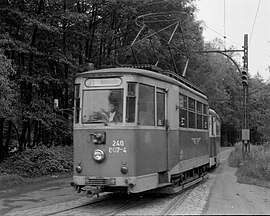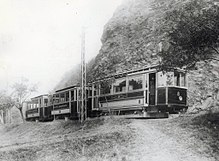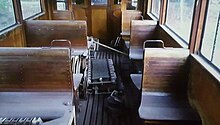Lockwitztalbahn
| Lockwitztalbahn | |||||||||||||||||||||||||||||||||||||||||||||||||||||||||||||||||||||||||
|---|---|---|---|---|---|---|---|---|---|---|---|---|---|---|---|---|---|---|---|---|---|---|---|---|---|---|---|---|---|---|---|---|---|---|---|---|---|---|---|---|---|---|---|---|---|---|---|---|---|---|---|---|---|---|---|---|---|---|---|---|---|---|---|---|---|---|---|---|---|---|---|---|---|
|
Line 31 train in Lockwitztal (1973)
| |||||||||||||||||||||||||||||||||||||||||||||||||||||||||||||||||||||||||
| Route length: | 9.2 km | ||||||||||||||||||||||||||||||||||||||||||||||||||||||||||||||||||||||||
| Gauge : | 1000 mm ( meter gauge ) | ||||||||||||||||||||||||||||||||||||||||||||||||||||||||||||||||||||||||
| Power system : | 550 V, from 1914 600 V = | ||||||||||||||||||||||||||||||||||||||||||||||||||||||||||||||||||||||||
| Maximum slope : | 31.8 ‰ | ||||||||||||||||||||||||||||||||||||||||||||||||||||||||||||||||||||||||
| Operating points of the Lockwitztalbahn 1976 | |||||||||||||||||||||||||||||||||||||||||||||||||||||||||||||||||||||||||
|
|||||||||||||||||||||||||||||||||||||||||||||||||||||||||||||||||||||||||
The Lockwitztalbahn was an overland tram in the Lockwitztal near Dresden between Kreischa and Niedersedlitz . The 9.2 km long route was built in 1905 and 1906. In 1977 operations were stopped.
Planning and construction
The plans for a rail connection between Kreischa and Niedersedlitz go back to 1895. At this time, the company Aktiengesellschaft Elektrizitätswerke OL Kummer & Co. of Oskar Ludwig Kummer in Niedersedlitz was planning to build a railway through the Lockwitztal . This should be part of a network of overland trams around Dresden and continue from Kreischa to Deuben . Despite a permit, however, Kummer initially worked on the Dresden suburban railway . In mid-1901, the company went bankrupt, so the plans were initially buried.
Since the communities of the Lockwitztal wanted to have the tram for economic reasons, they petitioned the 2nd Chamber of the Landtag in 1903 and asked the state to take responsibility for implementation. Finally, with the approval and an aid commitment to Kummer, the necessity of the tram was confirmed. After the petition was rejected, seven municipalities joined forces on November 15, 1904 to build the 9.2-kilometer route. Members of the association were the communities of Kreischa, Lockwitz , Sobrigau , Gombsen , Lungkwitz , Niedersedlitz and Saida / Wittgensdorf . The planning was the responsibility of the engineer Schwarz, who acquired Kummer's documents from his bankruptcy estate and developed them further. It was carried out by the United Felten & Guilleaume-Lahmeyer Werken AG. On August 24, 1905, construction of the meter-gauge line began. The contact wires and profiles were laid out in such a way that jacked up railroad cars can also run. The depot was set up in Kreischa and the turning system of the Dresden suburban railway was to be used in the Niedersedlitz train station . When the railway opened on March 2, 1906 , it ended on Bahnhofstrasse, 200 m from the train station, as the common end point had not yet been set up. Public operation began on March 3, 1906.
Operation in the community association
In addition to transporting people, the tram also carried the post along the route, which is why the post office in Kreischa was right next to the tram depot. The prices were initially 35 pfennigs for the entire route, 10 pfennigs from Niedersedlitz to Lockwitz, Oberer Gasthof. On May 16, 1906, bus stops were introduced because stopping them if necessary hindered operations too much. In the first few years there were also frequent problems due to construction defects, faults in the vehicles or floods and frost. The many bends in the valley also led to heavy wear. In 1907 the carriage hall in Kreischa was completed. Repeater trips between Niedersedlitz and Lockwitz introduced in the same year were almost completely canceled the following year due to insufficient demand. The joint use of the Niedersedlitz station forecourt as the end point with the Dresden suburban railway did not take long. From 1907 the Lockwitztalbahn only ran to the forecourt on the other side of the station. Initially, the operation of the railway was a loss, also because the railway could hardly be used for freight transport. In 1909 a mountain inn was opened together with the community association on the Wilisch . This made the railway more attractive and increased the number of passengers. Since the income was still insufficient, the fares were increased in 1912. By 1913 it had been in the black.
During the First World War , the timetable had to be restricted due to a lack of personnel. Therefore, women were hired for the first time. From 1915 on there was an increase in the transport of goods, as there was no longer any horse transport. Some of the sidecars have therefore been converted. At the end of the war and in the years after, there were already several price increases as costs continued to rise. In addition, the railway has already had to take out loans through various bad investments such as the purchase of cars from Zittau . Even the goods traffic that arose during the war could not be continued. In 1921 the railway finally came under compulsory administration by the state. Due to the additional financial burden caused by inflation , a closure was also considered in 1923. In 1924 the situation improved again and the business was handed over to a special purpose association of municipalities and the state, but the forced administration remained in place. In the same year, due to the re-gauging of the suburban railway and its merging into the urban network , the common end point in Niedersedlitz was finally lost.
Loans were still necessary for continued operation, also because the wagons were renewed and the route was modified again and again. After a loan from the Dresdner Überland-Verkehrsgesellschaft (DRÜVEG) could not be repaid, the DRÜVEG became the owner of the railway on January 1, 1929.
DRÜVEG and Dresdner Verkehrsbetriebe
In contrast to the other lines of the DRÜVEG, which were operated by the Dresdner Straßenbahn AG, in the case of the Lockwitztalbahn, the DRÜVEG took over this itself Transitional tickets introduced for the use of the Dresden tram lines. This initially led to a more economical operation. When in 1933/34 bus route D to Lockwitz was set up, first to the lower inn, then to Plan, the number of passengers fell. As a result, operations were restricted and some evasions were abandoned. With the beginning of the Second World War , the number of passengers rose again, also because bus traffic had to be reduced. In addition, there was a lack of staff and restrictions due to the blackout.
In 1941 the Dresdner Straßenbahn AG took over the DRÜVEG, so that the Lockwitztalbahn became part of the Dresden tram. At that time it was given line number 31, which led it until it was discontinued. With the change of ownership, the cream-colored paintwork with the three red-brown decorative stripes and the city tariff were also adopted. Now the train ran every 30 minutes, for which a new turnout had to be built. On February 14, 1945, the railway line was damaged by bombing in Lockwitz. On March 10, the damage had already been repaired and the whole route could be operated. Since the Gauleiter had his seat relocated to Lockwitz after the air raids on Dresden , the railway was hit by aircraft fire until the end of the war.
The railway experienced an upswing in the post-war period. Due to the fact that Dresden's population moved into the surrounding area, traffic in the direction of Dresden increased. In addition, the route was increasingly used for freight traffic. However, the lack of material and the destruction in the city made the necessary repairs difficult. After 1950 the wagons on line 31 were completely overhauled. The panoramic glazing of the city track cars was adopted for some of the railcars, which improved the overview for the tram driver. The railcars also received sliding doors. Furthermore, small sidecars were taken over from the Dresden transport company and converted to 1,000 mm gauge. In addition, a work railcar and the salt car were reactivated and in 1952 a railcar from Bad Schandau ( Kirnitzschtalbahn ) was purchased in order to be able to offer a quarter-hourly service. In 1956, a diploma thesis showed that the Lockwitztalbahn is used by around 2,400 passengers per day, as well as excursionists and school groups. The economic efficiency compared to a bus route was proven with this work.
Accordingly, the tram should continue to be operated and, from 1961, urgently needed renovations were carried out on the route. At the end of the 1960s, eight railcars that had been built between 1938 and 1944 were procured from Erfurt. With the exception of railcar 9 (240 101) from 1926, all old wagons could then be decommissioned until 1974. In addition to the railcars, the Dresden public transport company relocated eight Werführung sidecars from 1948 from the city network. In contrast to the normal Dresden color scheme, the new vehicles on the Lockwitztalbahn were painted green with cream-colored windows.
During the 1960s, the number of passengers fell, mainly because of the bus routes that now run to many places above the Lockwitztal and Kreischa. In the 1970s, the increasingly dense road traffic led to conflicts with motor vehicles and the number of excursionists decreased. In 1974 the city decided to replace the tram with a bus line in its transport concept. In 1975, the transport company determined that continued operation in accordance with the current requirements would be about as expensive as changing gauges to the city lane and more expensive than switching to bus traffic. In addition, from January 22, 1976, new operating rules for tram operations were in effect in the GDR . This contained new safety regulations that had not yet been implemented. In June 1977, the city council decided to shut it down, which now met with great resentment among the affected population, although the bus service could at least shorten the journey time from 30 to 21 minutes. The last trip took place on December 18, 1977. The traffic has now been taken over by the newly created bus route 96. Line 86 has been running since the bus route change in 2009.
After the shutdown
After the shutdown, three railcars were handed over to Brandenburg. The other five Erfurt wagons then drove on the Kirnitzschtalbahn . The railcar 240 101 was refurbished in the workshop of the Trachenberge depot and got its original red and white paint back in the Kirnitzschtal valley. Most of the tracks were dismantled in 1978. However, individual track sections remained in Kreischa and Niedersedlitz until the 1990s, and in Lockwitz until the 2010s. The workshop in Kreischa was still used by the Dresden transport company to repair wear parts until 1990.
After the fall of the Wall, an association was founded with the aim of erecting a monument to the Lockwitztalbahn. In 1993 the railcar 240 005 came back to Kreischa from the Kirnitzschtalbahn. Pushed by a tractor, he drove past the sanatorium on the broken tracks between Haussmannsplatz and the park restaurant. There it was erected as a memorial and restored to its original state. Over time the idea came up to build a museum tram between Hummelmühle and Kreischa . In 1995, railcar 240 004 came back to Kreischa for this purpose. Over time, however, this dream fell apart. The association later wanted to build a tram museum in the former Lockwitztalbahn depot, because the condition of the two motor coaches that were in the open was deteriorating noticeably. After the tracks in the Kreischa depot had been repaired, the two railcars could have started moving, but the municipality refused the two railcars their new domicile on the grounds that they had no more space for the winter litter stored there. After the dream of the tram museum had burst, the association gave up.
In summer 2007, the two railcars were removed from Kreischa. The railcar 240 005 came into the inventory of the Dresden Tram Museum , the railcar 240 004 serves in its original home in Erfurt as a spare part donor for the local special vehicles. The latter was brought back to Kreischa as a memorial from Erfurt on October 16, 2019 by the Kreischa eV model railway club.
On November 28, 1960, the post trailer built in 1908 by Gottfried Lindner AG Ammendorf , which went into operation with the number 35 and was numbered 3522 from 1948, was retired. The chassis and the brakes were scrapped, the car body with its steel frame was sold privately and initially served as a shed on a property in Bärenklause . At the beginning of the 1990s he was discovered there by a bus driver from DVB AG , bought by him for 1 DM and now moved to his property in Borthen . This was done with the intention of returning the post sidecar to its original condition. This was largely successful: with the exception of the top coat, the color production was carried out until 1999, and the subsequent purchase of wheelsets and axle bearings was also carried out on one's own initiative. However, further repairs were not possible and on June 17, 2012 the Dresden Tram Museum purchased the car. The paintwork was completed by 2013, the platform grids were reconstructed from historical photographs and the two axes were installed. Since then, it has been on display in the museum exhibition in a rollable condition.
Operating points
| Operating points of the Lockwitztalbahn | |||||||||||||||||||||||||||||||||||||||||||||||||||||||||||||||||||||||||||||||||||||||||||||||||||||||||||||||||
|---|---|---|---|---|---|---|---|---|---|---|---|---|---|---|---|---|---|---|---|---|---|---|---|---|---|---|---|---|---|---|---|---|---|---|---|---|---|---|---|---|---|---|---|---|---|---|---|---|---|---|---|---|---|---|---|---|---|---|---|---|---|---|---|---|---|---|---|---|---|---|---|---|---|---|---|---|---|---|---|---|---|---|---|---|---|---|---|---|---|---|---|---|---|---|---|---|---|---|---|---|---|---|---|---|---|---|---|---|---|---|---|---|---|
|
|||||||||||||||||||||||||||||||||||||||||||||||||||||||||||||||||||||||||||||||||||||||||||||||||||||||||||||||||
Individual evidence
- ↑ Stops from Mario Schatz: Meter gauge trams in Dresden . Verlag Kenning, Nordhorn, 2007, ISBN 978-3-933613-76-9 , p. 72, alternative points ibid p. 67 ff., 80, 91 and 99.
- ↑ Schatz, 2007, pp. 65–68
- ↑ Schatz, 2007, pp. 68-77
- ↑ Schatz, 2007, pp. 77-79
- ^ Schatz, p. 79.
- ↑ Schatz, 2007, pp. 79-83
- ↑ Schatz, 2007, pp. 83-94
- ↑ Schatz, 2007, pp. 98-102
- ↑ Schatz, 2007, p. 102 f.
- ^ Erfurt car park list, last accessed on October 6, 2011
- ↑ Mario Schatz: Post sidecar 35 of the Lockwitztalbahn (built in 1908) . In: Tram Museum Dresden e. V. (Ed.): The bell . Issue 50, June 2, 2013, p. 32.
- ↑ Stops from Mario Schatz: Meter gauge trams in Dresden . Verlag Kenning, Nordhorn, 2007, ISBN 978-3-933613-76-9 , p. 72, alternative points ibid p. 67 ff., 80, 91 and 99.
literature
- Helmut K. Missbach: Saxon overland trams since 1898. Transpress Verlag, Stuttgart 2004, ISBN 3-613712-43-1 .
- Mario Schatz: Meter gauge trams in Dresden . Kenning Verlag, Nordhorn, 2007, ISBN 978-3-933613-76-9 .







